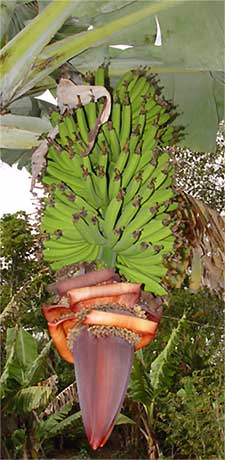Excerpts from Jim Conrad's
Naturalist Newsletter
from the February 13, 2005 Newsletter issued from Hacienda Komchen de Los Pájaros
just outside Dzemul, Yucatán, Mexico
BANANA TREES IN HOT, DRY WIND Here's a mental image that'll stay with me long after I leave Komchén. The aftgernoon sky is cloudless, the temperature in the shade lies between 85° and 90°, the wind is furious, and everything is dry, dry, dry. That's the way it now nearly every day.
Here's a mental image that'll stay with me long after I leave Komchén. The aftgernoon sky is cloudless, the temperature in the shade lies between 85° and 90°, the wind is furious, and everything is dry, dry, dry. That's the way it now nearly every day.
In fact, nowadays the banana trees along our entrance road are being dried out and beat ragged by the scorching wind. Some of the older leaves look like spears projected skyward, strung with narrow, dun- colored ribbons agitating like tinsil on a used-car- dealer's sky wires. The "spears" are the leaves' midribs, and the narrow ribbons are torn-apart sections of what once were single, broad, green blades.
One afternoon the glare from the road's white limestone gravel was so intense and the sunlight on my skin so unrelenting that I sought shelter inside a banana-tree thicket. While among the bananas I studied them closely and saw just what strange and wonderful beings they are.
First of all, it's almost misleading to call a banana tree a tree. If you think a tree needs a solid, branching trunk, then banana trees are not trees because their "trunks" are neither very solid nor branched. Banana plants rise from underground stolons. A stolon is a horizontal stem giving rise to a new plant at its tip. Therefore, the banana "tree" is actually an ephemeral banana "shoot," while the part of the plant living on year after year, issuing one shoot after another, is the underground stolon.
To understand what the banana shoot consists of, you need to know how average leaves are constructed. Typical leaves consist of a broad BLADE connected to the plant STEM by a PETIOLE. I provide a whole page helping beginning naturalists understand what's a leaf and what's not at www.backyardnature.net/whatleaf.htm.
The thing that looks like a banana-tree trunk consists of many LEAF PETIOLES nestled inside one another. Each leaf emerges from a kind of slit or groove atop the leaf petiole beneath it. When the shoot is mature enough a large inflorescence of flowers emerges from within the petiole of the last-produced leaf at the top of the plant. Once fruits are produced, the whole shoot dies.
Banana flowers are arranged on a drooping spike up to five feet long, with male flowers at the spike's tip, and female ones -- the ones that will form bananas -- located between the male flowers and the banana-shoot body. The male flowers consist of six stamens (one of them sterile) and each flower is subtended by a red-to- violet, scooplike bract. The pistils of the female flowers look like tiny, green bananas from the beginning. Fruits of wild banana species bear seeds, but fruits of horticultural varieties are seedless. Next time you eat a banana, notice the soft, dark, sandgrain-like affairs inside the fruit. Those are aborted seeds.
From what I can see, Komchén's black-and-blue Yucatan Jays and orange-and-black orioles eat far more of our banana fruits than we do. Long before the fruits start turning yellow the birds tear into them leaving brown gashes from one end to the other of the green, leathery fruit.
You may enjoy viewing a series of photos taken by a fellow chronicling the flowering and fruiting of his banana plant at www.wagonmaker.com/bananas.html.